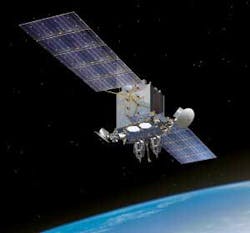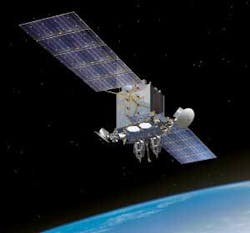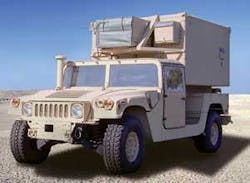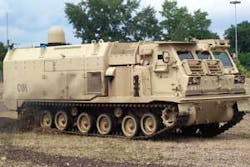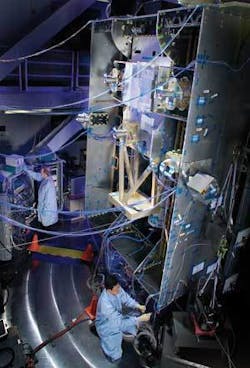Trends within the U.S. Department of Defense may slow development funding for next-generation satellite communications such as WIN-T, yet the promised technologies of these programs, such as Internet Protocol systems, continue to demonstrate successfully.
By John McHale
History has seen this happen before. Militaries stretched by global conflicts are forced to support their current operations often at the expense of programs that may prove decisive on future battlefields.
It may be happening again. U.S. military technology suppliers are seeing a trend within the DOD to hold off on funding for research and development to support current operations in Iraq and elsewhere.
It is the major trend right now, says Ric Vandermeulen, vice president and general manager for government SATCOM at ViaSat in San Diego. Driving this is the concept of asymmetrical warfare, fighting with smaller forces that can move quickly around the world-the War on Terror is an example.
There is pressure to pay for current military operations at the expense of technology development, he says. Technology for command and control on the move is one of the areas that the current procurement trend could slow, Vandermeulen adds.
There is talk within the Senate and House that they will want justification for the transition from the Joint Network Node (JNN) to the Warfighter Information Network-Tactical (WIN-T) before it can proceed. Military sources say members of Congress are questioning its immediate necessity.
Military leaders are basically saying that if industry can provide a technological solution that can show success right now in Iraq they will fund it by cutting funding for a program that would not be deployable for five to ten years.
This is also part of the commercial-off-the-shelf (COTS) procurement trend-buying COTS wherever and whenever possible versus full funding of developmental technologies, Vandermeulen says. The use of COTS has been instrumental in the success of communication systems, but developmental funding is also necessary, he adds.
It is the creation of markets for commercial technologies such as cellular phones and satellite communications that is making it plausible to move these technologies to the battlefield.
Twenty-five years ago cellular phones were expensive and bulky luxuries or in many minds science fiction; now practically everyone has one. That huge market made companies like Nortel into business giants, no matter how short-lived.
That is happening with Internet Protocol technology and satellite communications, Vandermeulen says. Companies are making satellite terminals for Internet access in rural areas at a cost of $49 a month. This is what makes these technologies so attractive to the military-not just their technical viability but their cost of implementation, he adds.
Internet Protocol
ViaSat Internet Protocol products are already in commanders’ hands through the U.S. military’s multiyear, multibillion-dollar plan to build one integrated network based on the Internet Protocol (IP).
TCP/IP (transmission control protocol/Internet protocol), developed under contract from the U.S. Department of Defense (DOD), lays out the rules of how the Internet formats and transmits data. TCP controls how data bytes move, and makes sure the information received is correct, while IP serves as the electronic post office by ensuring that messages get to the right address or addresses.
ViaSat LinkStar and LINKWAY IP-based satellite networking products, widely used in commercial enterprise networking, are the core networking technology for the Coalition Military Network (CMN), fielded by Lockheed Martin for U.S. Central Command (USCENTCOM), ViaSat officials say. Rather than several tactical Satcom units, the new commercial technology, under the Kuwait Iraq command, control, communications, and computers (C4) commercialization (KICC) project, is creating a permanent communications infrastructure that closely matches the capabilities of the military’s future Global Information Grid (GIG).
IP technology will give military commanders improved situational awareness. The faster communication will help create real-time pictures of a battlefield, and help leaders know where the enemy and U.S. troops are at all times, Vandermeulen says.
The CMN is designed to support more than 1,000 telephone lines as well as fast “cable modem-like” data access to the coalition Wide Area Network (WAN) backbone for USCENTCOM, one of five combatant commands worldwide. In addition, the direct terminal-to-terminal connectivity uses only one satellite hop that reduces satellite delay by 50 percent.
The success and capabilities of the network has led USCENTCOM to seek broader U.S. military acceptance and approval for the ViaSat commercial satellite networking system. Beginning in August, the LinkStar/LINKWAY bandwidth-on-demand system entered certification programs through the Joint Interoperability Test Command (JITC), funded by USCENTCOM, and the Joint User Interoperability Communications Exercise (JUICE), funded by the Defense Information Systems Agency (DISA). The certifications are expected to make it easier for military forces to begin wider deployment of the networking architecture, ViaSat officials say.
ViaSat engineers also demonstrated the equivalent of a DSL connection inside a moving military Humvee during the Command and Control On-the-Move (C2OTM) demonstration by the U.S. Joint Forces Command (USJFCOM) Joint C4ISR Battle Center last year.
The companies leading the way in command and control on the move are General Dynamics and Lockheed Martin. Their experts are already designing and demonstrating technologies for a network-centric force on the move through the Warfighter Information Network-Tactical (WIN-T), the U.S. Army’s next-generation battlefield network backbone.
WIN-T is the next evolution in battlefield communications after the Joint Network Node (JNN), says General Dynamics spokesman Chris Snapp.
The Joint Network Node (JNN) is a JNTC-compatible communications package that enables the warfighter to use advanced networking capabilities, retain interoperability with current force systems, and keep in step with the JNTC spiral. The JNN provides a suite of voice, video, and data communication tools designed to meet the needs of UA/UEx and Battalion Command Post structures. It is a rapidly deployable, early-entry system housed in an S-250 shelter and mounted on an ECV HMMWV for roll on/roll off mobility. The JNN typically takes about 30 minutes to setup, Snapp says.
In the run to Baghdad during the recent Iraq war, units were moving so fast that they would outrun the line-of-sight JNN. WIN-T will provide communications at all times from a non-line-of-sight perspective-satellite communications, Snapp says.
WIN-T
The Army concluded initial Development and Operational Tests (DT/OT) of the WIN-T last year. Completion of DT/OT, using real (not simulated) hardware and software at Fort Huachuca, Ariz., marks a major milestone in the WIN-T program.
“WIN-T works,” says Col. Angel Colon, the Army’s WIN-T program manager. “This network brings the Army into the future now. We’re ready for current force adoption of key WIN-T elements and are prepared for implementation into the Future Force.
“For the first time, we see critical technologies coming together in the field: dynamic bandwidth allocation with satellite communications on-the-move in a self-healing, self-forming network based on Quality of Service and operating over IPv4 and IPv6,” Colon says. “These technologies present an opportunity to truly revolutionize tactical communications. The network moves from PowerPoint to reality.”
The completed demonstrations confirm that technologies and subsystems in the next-generation warfighter network are mature and significantly reduce risk for fighting forces, General Dynamics Officials say. “The WIN-T tests are on track, on time, and on schedule,” Colon says. “These demonstrations show that we’re ready. “
WIN-T is a critical enabler of LandWarNet, the Army’s far-reaching effort to transform into joint, network-centric, knowledge-based warfare; the network provides a clear operational picture for theater combatant commanders by using true satellite on-the-move capabilities, robust network management and high-bandwidth radio systems to keep mobile forces connected, communicating and synchronized.
“Warfighters and commanders need high-bandwidth, self-forming networks to support highly mobile operations,” says Bill Weiss, vice president of tactical networks for General Dynamics C4 Systems. “At Fort Huachuca, the team showed how WIN-T provides a true on-the-move enterprise network, enabling mobile battle command over large distances. This mobile, high-speed network is a key underpinning of Future Combat Systems, and can also provide immediate benefits to the Current Modular Force.”
The critical advantage of WIN-T is its ability to give commanders the right information at all times, even when forces are moving-a capability not widely available today. That is the key enabler of WIN-T-to provide network connectivity while on the move, he says.
In a larger sense, WIN-T is one of four enabling technologies in the Pentagon’s effort to transform today’s military into a smaller, faster, more lethal force. In this vision, WIN-T and the Joint Tactical Radio System (JTRS) act as mobile battlefield networks, connected to two permanent, high-bandwidth pipelines-a terrestrial network called the Global Information Grid Bandwidth Expansion (GIG-BE) and a space-based network called the Transformational Satellite Communications system, or TSAT.
The WIN-T contract, worth $7 billion through 2018, was awarded in September 2004 to a team of General Dynamics C4 Systems in Taunton, Mass., and Lockheed Martin in Gaithersburg, Md. They report to the Army’s Communications and Electronics Command in Fort Monmouth, N.J.
Operational test of WIN-T will be performed in 2008 with operational capability expected in 2009, Weiss says
WIN-T also serves as the tactical extension of the Global Information Grid and is interoperable with joint forces, coalition forces and other government agency networks. General Dynamics leads a team of communications, network systems and platform integration experts on the program, including Lockheed Martin, BAE Systems, and Harris Corp.
BAE Systems has received certification for the WIN-T Operating Environment. The Joint Tactical Radio System Technology Laboratory (JTeL) has certified the initial operating environment for BAE Systems’ multiband JC4ISR radio as compliant to the Department of Defense’s Software Communications Architecture 2.2 specifications.
The certification, an important milestone in development of the radio, means that military forces will be able to communicate better and more widely in a combat arena. JC4ISR stands for joint command, control, communications, computers, intelligence, surveillance, and reconnaissance. The JC4ISR radio will enable two new ad-hoc and self-forming waveforms for high-band networking and SATCOM network-centric operations, as well as the Global Broadcast System receive waveform, BAE Systems officials say.
“With this radio, our military users will get the throughput, networking capability, and operational flexibility they need to meet urgent operational requirements today,” says Jeffrey Markel, BAE Systems president for Network Enabled Solutions in Wayne, N.J. JC4ISR radio also helps with the Army’s transition to JTRS, Markel adds.
The JTeL laboratory uses the BAE Systems Joint C4ISR and Advanced Joint C4ISR Node platforms to perform operating environment and waveform certifications. The core framework was developed using CMMI Level 5 software engineering processes and is targeted for use in JTRS.
The latest DOD budget request for Army research next year earmarks $158.2 million on WIN-T.
Successful test validates Lockheed Martin design for AEHF satellite
Lockheed Martin Space Systems in Sunnyvale, Calif., announced that it has completed a critical structural test of the Advanced Extremely High Frequency (EHF) spacecraft. The Advanced EHF system will provide global, highly secure, protected, survivable communications for all warfighters serving under the U.S. Department of Defense.
The test, known as a modal survey, is designed to validate the rigid characteristics of the spacecraft to ensure that launch and other sources of vibrations such as reaction wheels, solar arrays, and various deployable and steerable mechanisms will not impact the critical mission of the communications payload.
The test was performed by a team of engineers at Lockheed Martin Space Systems, facilities in Sunnyvale, Calif., and included 292 accelerometers, 508 accelerometer channels, and six shakers mounted to the structure and surrounding ground surface.
“Our highly successful modal testing and analysis has verified that we have a robust spacecraft design for achieving success on this critical mission,” says Julie Sattler, vice president, Lockheed Martin Space Systems. “Our team continues to make outstanding progress on the AEHF Program to aid our military personnel and allies worldwide.”
Based on Lockheed Martin’s flight-proven A2100 spacecraft series, Advanced EHF satellites will provide greater total capacity and offer channel data rates higher than that of Milstar communications satellites. The higher data rates permit transmission of tactical military communications such as real-time video, battlefield maps, and targeting data.
With the successful completion of modal testing, the spacecraft will be shipped to ATK in Corona Calif., for refurbishment and final painting prior to shipment to Lockheed Martin’s Mississippi Space & Technology Center for integration with its propulsion subsystem. Development of the first Advanced EHF satellite is also progressing on schedule and is planned for launch in April 2008.
Lockheed Martin is currently under contract to provide the three Advanced EHF satellites and command control system to its customer, the MILSATCOM Joint Program Office, located at the Space and Missile Systems Center, Los Angeles Air Force Base, Calif. Northrop Grumman Space Technology is the payload provider.
Cisco provides core network infrastructure for multinational military exercise
Cisco Systems is providing the core network infrastructure for Combined Endeavor 2006, a two-week operation in Lager Aulenbach, Germany designed to test and document the interoperability of vital communication systems for multinational forces deployed in humanitarian, peacekeeping and disaster relief efforts. Data gathered from earlier exercises has played a key role in recent multinational operations in Iraq, Afghanistan, Bosnia, and Kosovo as well as humanitarian operations in Pakistan and the tsunami-affected areas.
More than 1,000 tests beginning this week will focus mainly on the ability to pass data with a high level of security over an Internet Protocol (IP) backbone, using voice over Internet Protocol (VoIP), private mobile radio, high frequency, and satellite communications. Information assurance is another key focus area for the participating nations.
In cooperation with the German Ministry of Defense, the U.S. European Command is sponsoring the communications and information systems interoperability exercise. Forty-one nations are taking part, including NATO, Partnership for Peace and non-aligned or strategic partner nations.
“Combined Endeavor 2006 is breaking new ground in many of the network areas that are being tested such as in multinational information sharing,” says Air Force Brig. Gen. Thomas Verbeck, the director of the International Interoperability, Concepts, and Experimentation Directorate (ECJ9). “Our goal is to tackle these types of challenges long before the call comes to deploy, certainly as part of Phase Zero operations.”
Combined Endeavor officials knew from experience that upgrading its core backbone was crucial in working to ensure a more realistic test of simulated operational networks. Because the complex systems of more than 40 nations and organizations are involved, finding a common thread was the key to success, Cisco officials say. Since Cisco equipment is common to networking in most nations, the company is playing a major role in this year’s exercise.
“As military units worldwide are being challenged to perform at ever higher levels in conflicts and disaster recoveries, multinational forces are increasingly driving to an IP standard,” says Kevin MacRitchie, vice president of Global Defense Space and Security for Cisco’s Global Government Services Group.
Cisco technicians will provide real-time video teleconferencing and Web casting as well as the administrative local-area networks (LANs) that will register and transport information and analyze results.
Combined Endeavor 2006 (CE 06) is the 12th in the series of U.S. European Command (USEUCOM) sponsored “in-spirit-of” Partnership for Peace (PfP) exercises to identify, test, and document command, control, communications, and computer systems and information systems interoperability between NATO and PfP nations’ fielded military strategic and tactical communications information equipment systems. The overall objective is to develop an integrated interoperability guide to assist deployment planning within a coalition network.
For more on Cisco visit www.cisco.com.
Cromlech Telecommunications Corp. receives Satcom equipment order from DataPath
Officials at Datapath in Duluth, Ga., selected satellite communications equipment from Comtech EF Data Corp. in Tempe, Ariz., to support a major U.S. government program.
The order encompasses a variety of satellite modems, including the CDM-570/L satellite modem with an optional IP Module and the new SLM-5650 high-speed satellite modem. The SLM-5650 is compliant with the Defense Satellite Communications System (DSCS) requirements defined in Military Standard (MIL-STD)-188-165A.
Also included in the order are Comtech Vipersat Networks’ Vipersat Management System (VMS). VMS is a fully automated network and capacity management tool designed specifically for satellite networks, offering improved switching functionality, network configuration flexibility, and enhanced management and control features.
“These modems and network and capacity management tools support fixed, at-the-pause or on-the-move communications applications and will deliver specific feature sets required by this major government program,” says Fred Kornberg, president and chief executive officer of Comtech Telecommunications Corp., Comtech EF’s parent company.
Comtech EF Data Corp. manufactures a broad spectrum of satellite communications products, including Satellite Modems, TCP/IP Performance Enhancement Proxies, Converters, Amplifiers, Transceivers and Terminals. All products meet or exceed the standards published by Intelsat, Eutelsat, Insat, AsiaSat and other worldwide and regional satellite networks. Visit www.comtechefdata.com for more information.
DataPath is a global telecommunications systems integrator specializing in satellite earth terminals and network solutions. DataPath’s rapid deployment voice, video, and Internet communications solutions deliver mission-critical connectivity in extreme environments. For more information, visit www.datapath.com.
Comtech Vipersat Networks Inc. provides complete solutions that optimize bandwidth utilization for broadband IP-networks over satellite. The company’s products enable applications such as voice, data, video teleconferencing, video broadcast, and Internet/intranet delivery to a variety of industries. Product features include dynamic bandwidth allocation and switching, data carrier management, voice prioritization, data compression and acceleration, full mesh capabilities using Single Hop On Demand, and Multi-Transponder Mode. Visit www.vipersat.com for more information.
L-3 Communications announces bid to acquire U.K. secure radio and satellite communications provider
Leaders of L-3 Communications in New York and TRL Electronics plc in Gloucestershire, United Kingdom, announced that L-3 is bidding to acquire TRL.
The two companies have reached agreement on the terms of a recommended cash offer for the entire issued and to be issued share capital of TRL. The offer values the existing issued ordinary share capital of TRL at 89.7 million pounds (approximately U.S. $168.8 million). TRL’s Board of Directors is unanimously recommending that TRL shareholders approve the transaction.
TRL offers advanced radio and satellite communications systems, providing governments and defense organizations around the world with the tools to trace, locate, monitor, and defend transmissions, as well as to communicate securely.
The offer, which will be made by Lehman Brothers on behalf of L-3 Communications Group plc, a wholly owned subsidiary of L-3 Communications, is conditional on the consent of the United Kingdom Ministry of Defense (MOD) as well as other customary conditions. The business, which reported sales of approximately $26.3 million for the six months ended September 30, 2005, is expected to be slightly accretive to L-3’s earnings.
“Secure communications has been at the core of L-3’s business since the company was formed in 1997, and TRL brings even greater capability to several of our existing businesses,” said Frank C. Lanza, chairman and chief executive officer of L-3 Communications (Editor’s note: Lanza died suddenly on June 7). Lanza noted that TRL will be synergistic with L-3’s offerings in secure communications and encryption, as well as SatCom and surveillance products.
TRL has expertise in Electronic Counter Measures (ECM) to protect against subversive threats. Its recent ECM developments are focused on responsive radio jammers and denial-of-service devices. The company also is a provider of -off-the-shelf ECM and Electronic Warfare Support Measures (ESM) products and significant research and development for the U.K. MOD. TRL’s Electronic Security division is a specialist in the protection of sensitive electronic data during transmission and storage using cryptographic techniques, and it is a provider of the highest military grade ATM and IP network cryptography, company officials say.
For more about L-3 Communications, visit www.L-3Com.com. For more on TRL Electronics visit www.trltech.co.uk.
